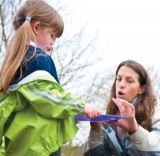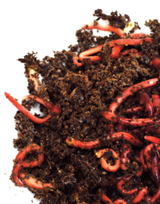Can children follow in Darwin's footsteps and investigate the science of summoning invertebrates from the soil, asks Deborah Herridge?
When Charles Darwin wasn’t voyaging around the world on the Beagle, you may well have found him in his garden looking for worms. Darwin became obsessed with earthworms. He decided to count how many were in his garden and, having decided there was an average of 53,767 worms per acre, he then moved most of them into his study and proceeded to investigate. He blew tobacco smoke at them, watched how they moved, ate and reproduced; he even got his son to play the bassoon to see how they responded to noise.
We don’t need to go quite that far, but the humble earthworm can prove a fascinating subject for investigations in the outdoors at any Key Stage.
 Ask the children if they have ever heard of ‘worm grunting’. In America it is sometimes called ‘worm snoring’ or ‘worm fiddling’ and it is the art of catching worms. Here’s how it’s done: you knock a wooden stake into the ground and rub it with steel. The noise and vibrations this creates drives the worms above ground.
Ask the children if they have ever heard of ‘worm grunting’. In America it is sometimes called ‘worm snoring’ or ‘worm fiddling’ and it is the art of catching worms. Here’s how it’s done: you knock a wooden stake into the ground and rub it with steel. The noise and vibrations this creates drives the worms above ground.
Worm charmers, as they are known in Britain, have many similar techniques to coax worms out of their burrows, including dancing on the ground to create vibrations. Tell the children they are going to investigate worms, and that they will begin this investigation by trying different techniques to charm the worms in your school grounds.
Explain to the children that Darwin, a very famous and important Victorian scientist, noticed that the soil in some areas of his garden seemed to contain more worms than others. The children are now going to follow in Darwin’s footsteps and try to find out which soil worms prefer.
 In order to get over the ‘yuk factor’ you may want to bring a worm into the classroom for the children to look at before they go on their own worm hunt. Try to keep the worm in soil and only disturb it for a few minutes. As the children are observing the worms you’ve brought into the classroom, ask them what they know about worms. Where do they live? What sort of places do we think they like? Can we find them everywhere? Are there places we’d expect to find no worms living – why? (e.g. on the playground or road because worms can’t burrow through tarmac or concrete, in dry exposed places etc.)
In order to get over the ‘yuk factor’ you may want to bring a worm into the classroom for the children to look at before they go on their own worm hunt. Try to keep the worm in soil and only disturb it for a few minutes. As the children are observing the worms you’ve brought into the classroom, ask them what they know about worms. Where do they live? What sort of places do we think they like? Can we find them everywhere? Are there places we’d expect to find no worms living – why? (e.g. on the playground or road because worms can’t burrow through tarmac or concrete, in dry exposed places etc.)
Identify different habitats around the school grounds e.g. open field, flowerbed, woodland (deciduous/coniferous), compacted soil, soil with lots of organic matter, pond verges etc. Urban schools with no grounds can look at grass verges and local parks.
Where do the children predict they will find most worms and why do they think this? What is it about a particular habitat that worms might like? What is the soil like in that particular area?
Now prepare your equipment. You will need:
• Garden spade or trowel
• Watering can with rose attachment
• Bottles of clean water (for cleaning the worms if very muddy – but don’t use too much, we don’t want to drown them!)
• Container with damp moss or soil to keep collected worms in the dark
• Quadrat or hoop
• Hand lenses
• Earthworm identification key (optional)
Ask children to choose three or four areas to survey. (You could use a quadrat or a hoop randomly thrown on the ground to select an area to investigate.) For each survey area, they should examine the soil and make notes on how it looks and feels - carefully remove turf if you need to but remember to put it back afterwards. Children need to make a note of the soil conditions in their target area before they start. Worms prefer damp soil; they are not happy in dry, dusty soil so pupils should prepare the ground by thoroughly dousing it with water 10 minutes or so before they start investigating.
It’s now time for children to practise their worm charming, but remind them to let the worms come fully to the surface before they attempt to pick them up. If their charming techniques fail to produce any worms, children can use a trowel to dig down into the earth to see if they can find any worms. Remember, not finding worms is as valid a result as finding lots.
Use this opportunity to look closely at the worms. Children should take a photographic record and make some field notes. What colour are the worms? How long are they? Do all of the worms have a saddle? Look at how the worms move. What do the children notice?
A worm identification guide can help pupils determine which species of worm are in the school grounds. These can be downloaded from the OPAL website (opalexplorenature.org/soilsurvey) along with other excellent resources for outdoor enquiry.
Count up your worms and make sure you return them to their habitat.
 Back in the classroom, encourage the children to find a method of presenting their results so that others can understand them; will they choose a drawing, a diagram, a table or perhaps a chart or graph? Can they explain why they have chosen a particular recording style? What is good about it; what is not so good?
Back in the classroom, encourage the children to find a method of presenting their results so that others can understand them; will they choose a drawing, a diagram, a table or perhaps a chart or graph? Can they explain why they have chosen a particular recording style? What is good about it; what is not so good?
They might make a habitat map or bar chart to show the population of worms in different areas. What conclusions can children draw from their data?
Ask the children to consider how their results may be used to reach a conclusion and answer their original questions. What do the results tell us? How much trust can we put in them? Did anything ‘go wrong’ or was anything unexpected; for example, were any areas completely without worms? Does that matter?
Can children spot any patterns in the results? Can they make some general statements about where worms like to live e.g. ‘the darker the soil, the more worms we found’ or ‘the crumblier the soil, the more worms we found’? Encourage the use of comparative language to form a conclusion.
Use this opportunity to explain to the children the idea of different animals being suited to different habitats. What is it about a worm that means it is suited to living in soil? Talk about what the children have discovered during their investigation and whether the investigation raised any further problems or questions they would like to investigate further?
Finally, if you want to take the investigation further and keep some worms in your classroom, you can buy worm habitats andcocoons for hatching over the internet (insectloreeurope.com).

• A worm has five hearts.
• There are about 1800 different species of earthworm. 28 species inhabit Britain.
• Earthworms are hermaphrodites, being both male and female at the same time.
• Some worms in South America can be up to eight feet long.
• Darwin got his calculations a bit wrong as on fertile land there can be one and three quarter million worms per acre.
• Worms breathe through their skin
• Worms do not like the cold weather.
• You are most likely to find them in the warmer months between March and October.
Deborah Herridge is a senior lecturer in primary science education at the University of Northumbria in Newcastle. Previously, Deborah was the CPD Leader at Science Learning Centre North East in Durham.
5 friendship and emotions intervention ideas
Ace-Classroom-Support
Behaviour management: choosing the right words
Behaviour Management
8 Ways To Get Your Class Drawing
Ace-Art-And-Design
